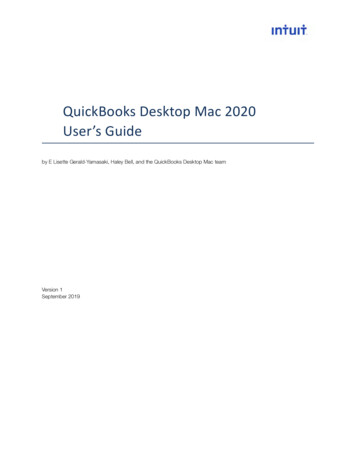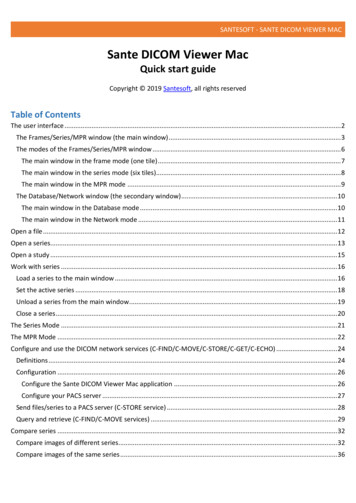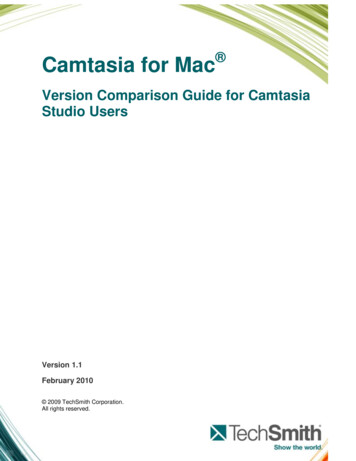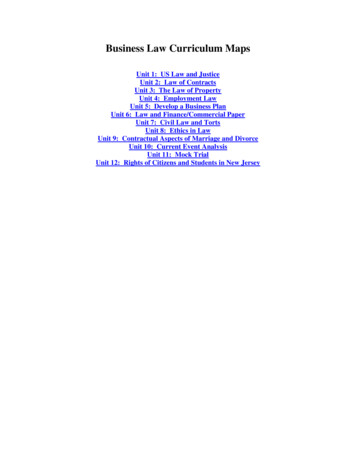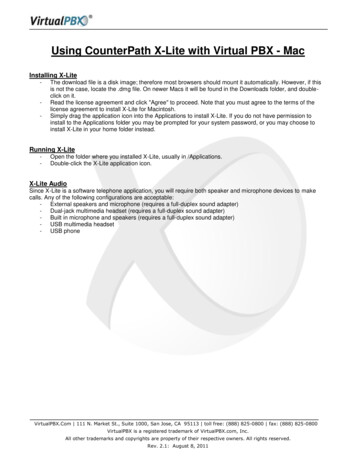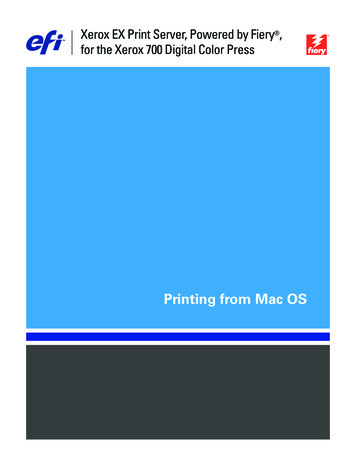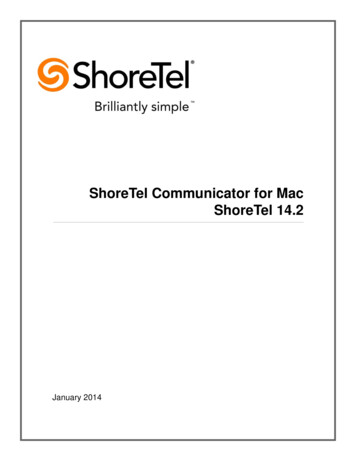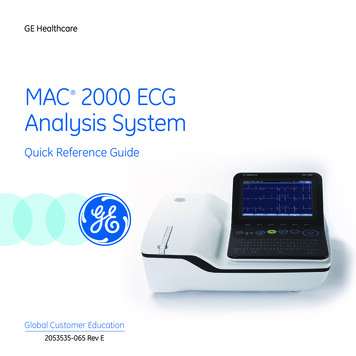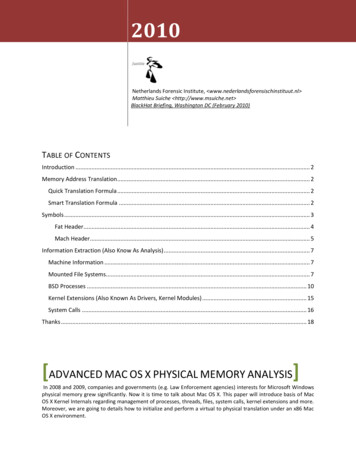
Transcription
2010Netherlands Forensic Institute, www.nederlandsforensischinstituut.nl Matthieu Suiche http://www.msuiche.net BlackHat Briefing, Washington DC (February 2010)TABLE OF CONTENTSIntroduction . 2Memory Address Translation. 2Quick Translation Formula . 2Smart Translation Formula . 2Symbols . 3Fat Header. 4Mach Header. 5Information Extraction (Also Know As Analysis) . 7Machine Information . 7Mounted File Systems. 7BSD Processes . 10Kernel Extensions (Also Known As Drivers, Kernel Modules) . 15System Calls . 16Thanks . 18[ADVANCED MAC OS X PHYSICAL MEMORY ANALYSIS]In 2008 and 2009, companies and governments (e.g. Law Enforcement agencies) interests for Microsoft Windowsphysical memory grew significantly. Now it is time to talk about Mac OS X. This paper will introduce basis of MacOS X Kernel Internals regarding management of processes, threads, files, system calls, kernel extensions and more.Moreover, we are going to details how to initialize and perform a virtual to physical translation under an x86 MacOS X environment.
ADVANCED MAC OS X PHYSICAL MEMORY ANALYSISINTRODUCTIONIn 2008 and 2009, companies and governments (e.g. Law Enforcement agencies) interests for Microsoft Windowsphysical memory grew significantly. Now it is time to talk about Mac OS X. This paper introduces Mac OS X KernelInternals regarding management of processes, threads, files, system calls, kernel extensions and more. We providedetails on how to initialize and perform a virtual to physical translation under a x86 Mac OS X environment.Physical Memory is widely known in the UNIX world as /dev/mem.MEMORY ADDRESS TRANSLATIONQUICK TRANSLATION FORMULAMost Operating Systems have a way to compute the kernel physical address even if you do not have the cr3register value which is used as Directory Table Base for virtual to physical address translation. If you want to havemore detailed information on this, please refer to Intel64 and IA-32 Architectures Software Developer’s Manuel:1Volume 3A System Programming Guide.By kernel physical addresses, I mean the kernel image ( DATA & CODE sections) physical address. Bothcontain important information and variables we need. For instance, to reconstruct the kernel address space weneed to be able to use Smart Translation Formula which requires variables we can retrieve using Quick TranslationFormula. As I said above, with Quick Translation Formula we can only access to DATA and CODE sections ofthe kernel image and not to allocated buffers.Here is a summary of some operating systems with their corresponding formula to translate from Kernel VirtualAddress (KVA) to Kernel Physical Address (KPA).Operating SystemQuick translation formulax86 LinuxPlayStation 3 Linuxx86 WindowsMac OS XKPA KVA – 0xC0000000KPA KVA - 0xC000000000000000KPA KVA & 0x1FFFF000KPA KVAAs you can see the formula for Mac OS X, is the easiest existing formula.SMART TRANSLATION FORMULAUsing Quick Translation Formula, we can retrieve variables from DATA section and initialized byslave pstart() function of Mac OS X Kernel, which is called during the Operating System initialization.13.6 PAGING (VIRTUAL MEMORY) OVERVIEW.2Introduction NFI
There are 4 variables which are interesting to perform the Smart Translation Formula: IdlePDPT,IdlePDPT64, IdlePML4 and IdlePTD.IdlePML4 variable is initialized even on 32-bits Operating System. PML4 stands for Page Map Level 4 pagingstructure. This method can be used to address up to 2 27 pages, which spans a linear address space of 2 48 bytes.Then, using IdlePML4 variable we can cover a translation mechanism for a linear address space of 2 48 byteseven if the processor cannot do it. Internally, in kernel structures, Mac OS X is using 64-bits addressing for memoryobjects.These variable are used later to initialize kernel map and kernel pmap kernel structures/variables.Here is a common output of these variables under Mac OS X Leopard.* 0 21 01 0000 00 00 0000 00 00 0000 00 00 0000 00 00 0000 00 00 00 0x0121900000 00 00 - 0000 00 00 - 0000 00 00 - 0000 00 00 - 0000 00 00 - 0000 00 00 - 000000000000000000000000000000000000.* IdlePDPT64: [0x004EB010]0x0121A000: 27 C0 21 01 000x0121A010: 27 E0 21 01 000x0121A020: 00 00 00 00 000x0121A030: 00 00 00 00 000x0121A040: 00 00 00 00 000x0121A050: 00 00 00 00 00 0x0121A00000 00 00 - 2700 00 00 - 2700 00 00 - 0000 00 00 - 0000 00 00 - 0000 00 00 - 000000000000000000000000000000000000.* 0 21 01 00E0 21 01 0000 00 00 0000 00 00 0000 00 00 0000 00 00 00 0x0121B00000 00 00 - 0100 00 00 - 0100 00 00 - 0000 00 00 - 0000 00 00 - 0000 00 00 - 000000000000000000000000000000000000.* 0:0x0121C040:0x0121C050:636323636363[0x004EB004]50 02 01 0070 02 01 0090 02 01 00B0 02 01 00D0 02 01 00F0 02 01 00 0x0121C00000 00 00 - 6300 00 00 - 6300 00 00 - 2300 00 00 - 6300 00 00 - 6300 00 00 - 000000000000000000000000000000000000cP.c .cp.c.c.c.c.c.c.c.SYMBOLSSymbols are a key element of volatile memory forensics without them an advanced analysis is impossible. Symbolsof Microsoft Windows are available on a remote server as standalone files, but on Mac OS X symbols are directlystored inside the executable in a segment/section called LINKEDIT.3Symbols NFI
The easiest way to retrieve kernel symbols is to extract them from the kernel executable of the hard-drive.Symbols are firstly used to retrieve the address of memory variable for Smart Translation Formula.FAT HEADERMac OS X file format follows the FAT file format which contains magic signature of the header and the number ofdifferent architectures entries (i386, PowerPC or Both) inside the executable in big endian.#define FAT MAGIC 0xBEBAFECAtypedef struct FAT HEADER{ULONG magic;ULONG nfat arch;} FAT HEADER, *PFAT HEADER;To jump to the first architecture entry we add sizeof(FAT HEADER) bytes to the pointer of the file header.Earch entry uses the following definition, and also uses the big endian endianess.typedef struct FAT ARCH{cpu type t cputype;cpu subtype t cpusubtype;ULONG offset;ULONG size;ULONG align;} FAT ARCH, *PFAT ARCH;The first field, cpu type, indicates to the loader what kind of architecture this entry defines using the followingdescription:typedef enum{CPU TYPE VAX 1,CPU TYPE ROMP 2,CPU TYPE NS32032 4,CPU TYPE NS32332 5,CPU TYPE MC680x0 6,CPU TYPE I386 7,CPU TYPE MIPS 8,CPU TYPE NS32532 9,CPU TYPE MC98000 10,CPU TYPE HPPA 11,CPU TYPE ARM 12,CPU TYPE MC88000 13,CPU TYPE SPARC 14,CPU TYPE I860 15,CPU TYPE ALPHA 16,CPU TYPE POWERPC 18,/* APPLE LOCAL 64-bit */CPU TYPE POWERPC 64 (18 CPU IS64BIT),/* APPLE LOCAL x86 64 */CPU TYPE X86 64 (CPU TYPE I386 CPU IS64BIT)} cpu type t;4Symbols NFI
And the third field, offset, contains the raw offset of the architecture header.We assume index x is the id of the CPU TYPE I386 architecture. So we have FAT ARCH[x].cputypeequals to CPU TYPE I386 and FAT ARCH[x].offset as new pointer offset to the MACH HEADERstructure.MACH HEADERNow we have a pointer the i386 architecture binary using the following header definition and little-endianendianess.#define MH MAGIC 0xfeedfacetypedef struct MACH HEADER{ULONG Magic;cpu type t cputype;cpu subtype t cpusubtype;ULONG filetype;ULONG ncmds;ULONG sizeofcmds;ULONG flags;} MACH HEADER, *PMACH HEADER;This architecture validity can be verified using the 0xfeedface magic key.Now we can read what Apple calls commands, the field MACH HEADER.ncmds indicates the number ofcommands inside the Mach-O binary.We have to add sizeof(MACH HEADER) to the Mach-O header pointer to have a pointer to the first commandentry. There are different commands types and size of commands depends of their type. Most importantcommands types are LC SEGMENT and LC SYMTAB.#define LC SEGMENT 0x1#define LC SYMTAB 0x2/* file segment to be mapped *//* link-edit stab symbol table info (obsolete) */And very two first fields contains information about the command’s type and its size, using the followingscheme:typedef struct LOAD COMMAND {ULONG cmd;/* type of load command */ULONG cmdsize; /* total size of command in bytes */} LOAD COMMAND, *PLOAD COMMAND;Command type called LC SYMTAB, contains raw pointers to two different tables. One, called symoff, withNLIST structures-based entries, and another, called stroff, with functions and variables names of eachcorresponding entry in the same order.typedef struct SYMTAB COMMAND{ULONG cmd;ULONG cmdsize;5Symbols NFI
ULONG symoff;ULONG nsyms;ULONG stroff;ULONG strsize;} SYMTAB COMMAND, *PSYMTAB COMMAND;typedef struct NLIST{ULONG n strx;UCHAR n type;UCHAR n sect;USHORT n desc;ULONG n value;} NLIST, *PNLIST;Both symoff and stroff are pointer into the LINKEDIT segment. Please note we have to addFAT ARCH[x].offset value to these fields. And n value field from NLIST structure contains the symboloffset.Here is a short dump of symbols retrieved from Mac OS X Leopard nstructors used.destructors lspecIS 64BIT 0043008E0x0042FE68Symbols NFI
[013859][013860][013861][013862][013863][013864]zt ent zindexzt find znamezt getNextZonezt get zmcastzt remove zoneszt set 8CDD0x002990B6INFORMATION EXTRACTION (ALSO KNOW AS ANALYSIS )Once memory manager is functional, we can now proceed to the extraction of information such as process list andso on.MACHINE INFORMATIONMachine identification is a very important part to validate result. This section covers how to retrieve Darwinversion, compilation date, number of CPUs and available memory on the current system.There is a global variable, accessible from symbols, called version which contains a 100 bytes string with O.S.Type, O.S. Release version, username who compiled it.There is another global variable, accessible from symbols, called machine info defined by machine infostructure which contains information about CPUs and Memory of the target machine.Definition of machine info structure can be retrieved in xnu/osfmk/mach/machine.h header file.Below is the definition of machine info structure under Mac OS X Snow Leopard.struct machine info {integer t major version; /* kernel major version id */integer t minor version; /* kernel minor version id */integer t max cpus; /* max number of CPUs possible */uint32 t memory size; /* size of memory in bytes, capped at 2 GB */uint64 t max mem; /* actual size of physical memory */uint32 t physical cpu; /* number of physical CPUs now available */integer t physical cpu max; /* max number of physical CPUs possible */uint32 t logical cpu; /* number of logical cpu now available */integer t logical cpu max; /* max number of physical CPUs possible */};Above is a screenshot of extraction information showing the target machine is running Mac OS X Leopard 10.5.0with 1GB of physical memory.MOUNTED FILE SYSTEMS7Information Extraction (Also Know As Analysis) NFI
Mounted file systems are defined by a global list-head, accessible from symbols, called mountlist. mountlistis a single link-list and contains a pointer called next which is a pointer to the next mounted file system entry bothare defined by mount structure.This structure contains 3 important fields including: file system type (f fstypename), directory on whichmounted (f mntonname) and mounted file system (f mntfromname).Definition of mount structure can be retrieved in xnu/bsd/sys/mount internal.h header file.Below is the definition of mount structure under Mac OS X Snow Leopard./** Structure per mounted file system. Each mounted file system has an* array of operations and an instance record. The file systems are* put on a doubly linked list.*/struct mount {TAILQ ENTRY(mount) mnt list;/* mount list */int32 tmnt count;/* reference on the mount */lck mtx tmnt mlock;/* mutex that protects mount point */struct vfsops*mnt op;/* operations on fs */struct vfstable*mnt vtable;/* configuration info */struct vnode*mnt vnodecovered;/* vnode we mounted on */struct vnodelstmnt vnodelist;/* list of vnodes this mount */struct vnodelstmnt workerqueue; /* list of vnodes this mount */struct vnodelstmnt newvnodes;/* list of vnodes this mount */uint32 tmnt flag;/* flags */uint32 tmnt kern flag;/* kernel only flags */uint32 tmnt lflag;/* mount life cycle flags */uint32 tmnt maxsymlinklen;/* max size of short symlink */struct vfsstatfs mnt vfsstat;/* cache of filesystem stats */qaddr tmnt data;/* private data *//* Cached values of the IO constraints for the device */uint32 tmnt maxreadcnt;/* Max. byte count for read */uint32 tmnt maxwritecnt; /* Max. byte count for write */uint32 tmnt segreadcnt;/* Max. segment count for read */uint32 tmnt segwritecnt; /* Max. segment count for write */uint32 tmnt maxsegreadsize; /* Max. segment read size */uint32 tmnt maxsegwritesize; /* Max. segment write size */uint32 tmnt alignmentmask; /* Mask of bits that aren't addressablevia DMA */uint32 tmnt devblocksize; /* the underlying device block size */uint32 tmnt ioqueue depth; /* the maxiumum number of commands adevice can accept */uint32 t mnt ioscale; /* scale the various throttles/limits imposedon the amount of I/O in flight */uint32 tmnt ioflags;/* flags for underlying device */pending io t mnt pending write size; /* byte count of pending writes */pending io t mnt pending read size; /* byte count of pending reads */lck rw t mnt rwlock;/* mutex readwrite lock */lck mtx t mnt renamelock; /* mutex that serializes renames that changeshape of tree */vnode t mnt devvp; /* the device mounted on for local file systems */8Information Extraction (Also Know As Analysis) NFI
uint32 tmnt devbsdunit; /* the BSD unit number of the device */void *mnt throttle info; /* used by the throttle code */int32 t mnt crossref; /* refernces to cover lookups crossing into mp*/-veint32 tmnt iterref; /* refernces to cover iterations; drained makes it*//* XXX 3762912 hack to support HFS filesystem 'owner' */uid tmnt fsowner;gid tmnt fsgroup;struct labelstruct label*mnt mntlabel;*mnt fslabel;/* MAC mount label *//* MAC default fs label *//** cache the rootvp of the last mount point* in the chain in the mount struct pointed* to by the vnode sitting in '/'* this cache is used to shortcircuit the* mount chain traversal and allows us* to traverse to the true underlying rootvp* in 1 easy step inside of 'cache lookup path'** make sure to validate against the cached vid* in case the rootvp gets stolen away since* we don't take an explicit long term reference* on it when we mount it*/vnode tmnt realrootvp;uint32 tmnt realrootvp vid;/** bumped each time a mount or unmount* occurs. its used to invalidate* 'mnt realrootvp' from the cache*/uint32 tmnt generation;/** if 'MNTK AUTH CACHE TIMEOUT' is* set, then 'mnt authcache ttl' is* the time-to-live for the per-vnode authentication cache* on this mount. if zero, no cache is maintained.* if 'MNTK AUTH CACHE TIMEOUT' isn't set, its the* time-to-live for the cached lookup right for* volumes marked 'MNTK AUTH OPAQUE'.*/intmnt authcache ttl;/** The proc structure pointer and process ID form a* sufficiently unique duple identifying the process* hosting this mount point. Set by vfs markdependency()* and utilized in new vnode() to avoid reclaiming vnodes* with this dependency (radar 5192010).*/pid tmnt dependent pid;void*mnt dependent process;};9Information Extraction (Also Know As Analysis) NFI
Above is a screenshot of mounted file systems including an external hard-drive.BSD PROCESSESEvery Operating System uses user-land processes, it is one of the key element of a working O.S.Loaded processes are stored into proc structure which contains a double-list to walk into the list. There is a globalvariable, retrievable from symbols, called kernproc is the list-head of BSD processes list.p list field is a double link-list which contains a pointer to both, the previous and the next process.Definition of proc structure can be retrieved in xnu/bsd/sys/proc internal.h header file.Below is the definition of proc structure under Mac OS X Snow Leopard./** Description of a process.** This structure contains the information needed to manage a thread of* control, known in UN*X as a process; it has references to substructures* containing descriptions of things that the process uses, but may share* with related processes. The process structure
physical memory grew significantly. Now it is time to talk about Mac OS X. This paper will introduce basis o f Mac OS X Kernel Internals regarding management of processes, threads, files, system calls, kernel extensions and more. Moreover, we are going to details how to initialize and perform a virtual




